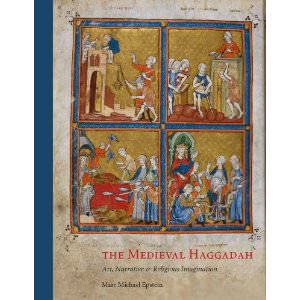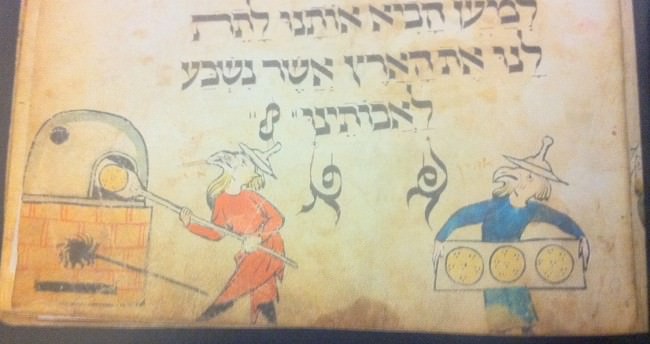Traveling within the World
Linking your favorite traveling artists across the globe
Birds’ Head Haggadah – scholar gives new insights into Jewish medieval text
The Birds’ Head Haggadah, a manuscript dating from around the year 1300, is considered one of the most interesting and mysterious pieces of Jewish art from the Middle Ages. In “Birds Head Revisited: Identity, Politics and Polemics the Birds’ Head Haggadah”, a special lecture held at the University of Toronto last month, Professor Marc Michael Epstein offered some new insights into this work, the earliest surviving illustrated version of the Haggadah text.
Readers of this particular Haggadah, which is a collection of prayers, illustrations, and stories recited on the Jewish holiday of Passover, will immediately notice that all of the illustrated Jewish figures are not depicted as people, but appear to have bird’s heads on the bodies of human beings. Epstein, Professor of Religion at Vassar College, explains that the figures are drawn to be Griffins, which were very popular figures in medieval Jewish literature.
The Birds’ Head Haggadah is one of a whole series of manuscripts from medieval France and Germany that were deliberately illustrated not to show the human faces. In others medieval texts other kinds of animal heads were used instead. Meanwhwile, the Birds’ Head Haggadah originally depicted the non-Jewish characters in its illustrations as having blank faces – centuries later faces were drawn onto these figures.
One of the main topics of Professor Epstein’s discussion were the illustrations found on folios 25v and 26r of the Haggadah, which depict the making of Matzah, an unleavened bread traditionally eaten by Jews during the week-long Passover holiday. Epstein believes these illustrations, which show the pricking of the bread and then placing it into an oven, were meant to counter accusations from the Christian community that the preparation of Matzah was a mockery and attack towards the Christian practice of Communion.
Epstein notes that in the 13th century religious persecution against Jews in medieval Europe became more widespread, and that accusations were made against local Jewish communities of the ritual murder of children, using blood for magic, and the desecration of the Eucharist. Several medieval writers described how “Jews were tempted to relive the crucifixion” by stealing pieces of the Christian Eucharist and making various attacks upon it. Christian theologians even saw Matzah as a kind of Jewish imitation of Christian practices, and were worried that some nefarious means were being used in its baking process.
By depicting the very mundane and regular practices involved in making Matzah bread, the illustrator of the Birds’ Head Haggadah was, in Epstein’s view, trying to explain that this baking process was not evil or threatening as Christians believed. It can be seen as an attempt by the Jewish community to counter the increasingly anti-Jewish views that were coming from various parts of Christian Europe.
 Epstein also used the lecture to discuss some other interesting aspects of the Birds’ Head Haggadah, such as why certain Jews were portrayed in the illustrations wore hats and beards, while others did not. His research is also detailed in his book The Medieval Haggadah: Art, Narrative and Religious Imagination, which was published last year by Yale University Press. The book examines the Birds’ Head Haggadah and three other Haggadot from the early 14th century.
Epstein also used the lecture to discuss some other interesting aspects of the Birds’ Head Haggadah, such as why certain Jews were portrayed in the illustrations wore hats and beards, while others did not. His research is also detailed in his book The Medieval Haggadah: Art, Narrative and Religious Imagination, which was published last year by Yale University Press. The book examines the Birds’ Head Haggadah and three other Haggadot from the early 14th century.
Epstein writes: “During the early thirteenth century, by which time Jewish settlement had spread throughout Christendom, Jews in both Ashkenaz and Sepharad developed a renewed interest in narrative painting coterminous with the emergence of Christian narrative art from monastic contexts into urban workshops. By the early fourteenth century, narrative, figurative art in Jewish culture had reemerged and reached its most articulated development. The manuscripts I will examine are products of that renaissance.”
http://www.medievalists.net/2012/04/03/birds-head-haggadah-scholar-...
Tags:
Replies to This Discussion
-
Permalink Reply by Dept of PMM Artists & things on April 3, 2012 at 3:33pm
-

Birds` Head Haggadah
Germany
ca.1300
Birds’ Head Haggadah
Southern Germany , ca. 1300
Scribe: Menahem
Parchment, ink, tempera
27 x 18.2 cm
Purchased through the gift of Fred Monosson, Boston
180/57; M912-4-46
Photograph: Moshe Caine
The Birds’ Head manuscript, the earliest illustrated Ashkenazi Haggadah to have survived as a separate book, rather than as part of the mahzor (holiday prayer book), contains richly colored depictions of biblical, ritual and allegorical scenes. Its name is derived from the human figures depicted in the Haggadah, who have birds’ heads with pronounced beaks. The enigmatic practice of drawing bird and animal heads in place of human faces is found in other medieval Ashkenazi manuscripts; it has yet to be fully explained, but may relate to a strict observance of the biblical prohibition against making graven images. All the adult males in the Haggadah wear the conical “Jewish hat” that was compulsory for Jews in Germany during the Middle Ages.
The codex, written in square Ashkenazi script, features two full-page miniatures; initial-word panels, and many marginal text illustrations. The scribe’s name appears to have been Menahem,as he marked in the text the consonants that spell his name. The same scribe wrote and similarly indicated his name in the Leipzig Mahzor, also written around that date. -
Events
-
2014 is the Chinese Year of the Horse
February 17, 2026 at 12am to February 5, 2027 at 12am – where & how you choose
Birthdays
Birthdays Today
Birthdays Tomorrow
Important (read & understand)
Skype: Travelingraggyman
Email and Instant Messenger:
TravelerinBDFSM @ aol/aim; hotmail; identi.ca; live & yahoo
OR
Travelingraggyman @ gmail and icq ***

1AWARD UPDATES & INFORMATION
10,000 votes - Platinum Award
5,000 votes - Gold Award
2,500 votes - Silver Award
1,000 votes - Bronze Award
300 votes - Pewter Award
100 votes - Copper Award
Member of the Associated Posting System {APS}
This allows members on various sites to share information between sites and by providing a by line with the original source it credits the author with the creation.
Legal Disclaimer
***************We here at Traveling within the World are not responsible for anything posted by individual members. While the actions of one member do not reflect the intentions of the entire social network or the Network Creator, we do ask that you use good judgment when posting. If something is considered to be inappropriate it will be removed
Site Meter
This site is strictly an artist operational fan publication, no copyright infringement intended
Patchwork Merchant Mercenaries had its humble beginnings as an idea of a few artisans and craftsmen who enjoy performing with live steel fighting. As well as a patchwork quilt tent canvas. Most had prior military experience hence the name.
Patchwork Merchant Mercenaries.
Vendertainers that brought many things to a show and are know for helping out where ever they can.
As well as being a place where the older hand made items could be found made by them and enjoyed by all.
We expanded over the years to become well known at what we do. Now we represent over 100 artisans and craftsman that are well known in their venues and some just starting out. Some of their works have been premiered in TV, stage and movies on a regular basis.
Specializing in Medieval, Goth , Stage Film, BDFSM and Practitioner.
Patchwork Merchant Mercenaries a Dept of, Ask For IT was started by artists and former military veterans, and sword fighters, representing over 100 artisans, one who made his living traveling from fair to festival vending medieval wares. The majority of his customers are re-enactors, SCAdians and the like, looking to build their kit with period clothing, feast gear, adornments, etc.
Likewise, it is typical for these history-lovers to peruse the tent (aka mobile store front) and, upon finding something that pleases the eye, ask "Is this period?"
A deceitful query!! This is not a yes or no question. One must have a damn good understanding of European history (at least) from the fall of Rome to the mid-1600's to properly answer. Taking into account, also, the culture in which the querent is dressed is vitally important. You see, though it may be well within medieval period, it would be strange to see a Viking wearing a Caftan...or is it?
After a festival's time of answering weighty questions such as these, I'd sleep like a log! Only a mad man could possibly remember the place and time for each piece of kitchen ware, weaponry, cloth, and chain within a span of 1,000 years!! Surely there must be an easier way, a place where he could post all this knowledge...
Traveling Within The World is meant to be such a place. A place for all of these artists to keep in touch and directly interact with their fellow geeks and re-enactment hobbyists, their clientele.
© 2025 Created by Rev. Allen M. Drago ~ Traveler.
Powered by
![]()
